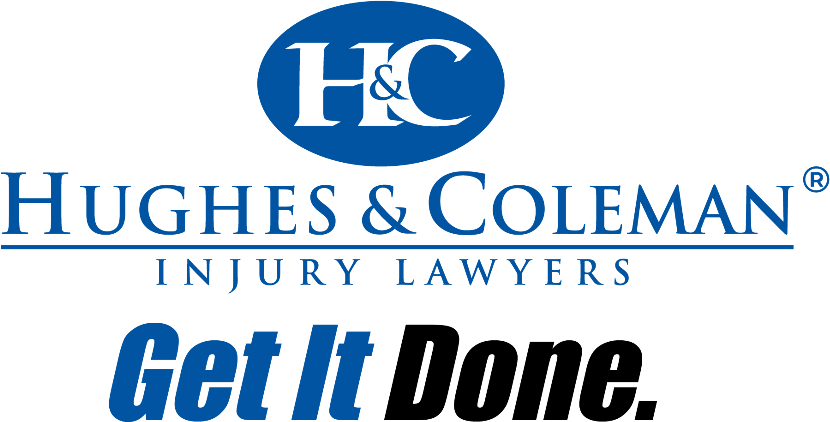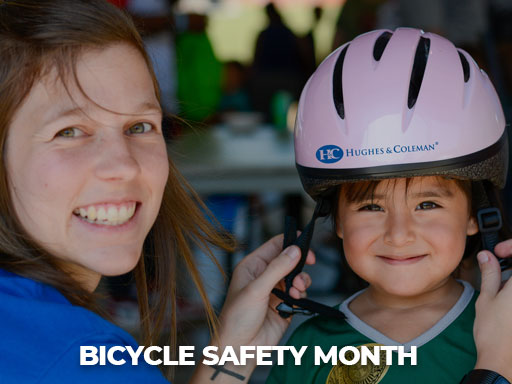-

Cycling enthusiasts across the country celebrate the many benefits of cycling during National Bike Month. In honor of National Bicycle Awareness Month, we’ve compiled a list of helpful bicycle safety tips to help keep riders and motorists safe throughout the season.
National Bicycle Awareness Month has a long history.
The League of American Bicyclists established National Bicycle Awareness Month in 1956. The goal was to encourage individuals to ride bikes for good physical activity. National Bicycle Awareness Month programs in previous years have emphasized bicycle safety, and this year we continue this tradition of educating all who share the road.
Visit Our Offices For a $5 Helmet and a Free Helmet Fitting.
Hughes & Coleman Injury Lawyers supports National Bicycle Awareness Month and the people of Kentucky and Tennessee by offering $5 U.S. Consumer Product Safety Commission (CPSC) certified helmets and free fittings by our trained staff year-round. Visit our website for a list of office locations and business hours, and drop by to get fitted today.
Bicycling Has Many Benefits
Physical activity is required to be fit and healthy. Obesity, heart disease, cancer, mental illness, diabetes, and arthritis can all be prevented via regular physical activity. Regularly riding your bicycle is one of the most effective strategies to lower your risk of health problems linked to a sedentary lifestyle.
Cycling is a low-impact, healthy activity that may be enjoyed by people of all ages, from toddlers to seniors. It’s also enjoyable, inexpensive, and environmentally friendly.
Riding to work or the store is one of the quickest ways to include regular exercise into your daily routine. Every day, an estimated one billion people use bicycles for transportation, entertainment, and sport.
Cycling is mostly an aerobic activity, meaning it works your heart, blood vessels, and lungs. You will breathe deeper, sweat more, and have a higher body temperature, all of which will improve your overall fitness. Regular riding has the following health benefits:
- Improved cardiovascular health
- Enhanced muscle flexibility and strength
- Better joint mobility
- Reduced stress levels
- Better posture and coordination
- Stronger bones and lower body fat levels
- Reduced anxiety and depression
Important Bicycle Safety Statistics
- In 2021, Kentucky bicyclists were involved in 325 crashes resulting in 239 injuries and 9 deaths. Of those crashes, 320 involved at least one other vehicle.
- Kentucky is ranked number 20 in the top 20 most dangerous states for pedestrians.
- Tennessee also shares a place in the top 20 most dangerous states for pedestrians and ranks number 12 nationally.
- In 2021, Tennessee saw 321 crashes involving cyclists, including five fatalities.
- Wearing a helmet reduces the likelihood of all head injuries by 48%.
- Wearing a helmet reduces the likelihood of serious head injuries by 60%.
Bicycle Safety Tips for Riders
- Make sure your bicycle is ready to ride before you use it. Always inspect your bike to ensure that all parts and equipment are secure and functioning properly for safe riding.
- Keep these tips in mind to stay safe on the road:
- Wear a bicycle helmet that is properly fitted. The helmet should be comfortable all the way around, level, and stable enough to withstand even intense shakes or hard hits while remaining in place. To maximize side coverage, it should be worn low on the head and held level on the head with the strap pleasantly firmly snug. Visit helmets.org to learn more about bicycle helmets and their benefits.
- Adjust the fit of your bicycle. Stand in front of your bicycle. If you’re riding a road bike, there should be 1 to 2 inches between you and the top tube (bar), and 3 to 4 inches if you’re riding a mountain bike. Front to back, the seat should be level. When the leg is fully extended, the seat height should be adjusted to allow for a modest bend in the knee. The handlebar height should be equal to the seat height.
- Examine your bike. Before you ride, make sure your tires are properly inflated and your brakes are working.
- Be seen. You need to be visible by others whether riding at dawn, dusk, nighttime, or through bad weather. It has not been proven that wearing white makes you more noticeable. When biking at night or during the day, wear reflective materials, neon, fluorescent, or other bright colors. Wear anything reflective, such as reflective tape or markings, or flashing lights, as well. Keep in mind that just because you can see a driver does not guarantee the driver can see you.
- Have complete control over your bicycle. Always keep at least one hand on the handlebars when riding. Use a bicycle carrier or backpack to transport books and other goods.
- Avoid road hazards. Potholes, broken glass, gravel, puddles, leaves, and dogs are all potential risks. All of these dangers can lead to a collision. If you’re biking with friends, call out and point to the hazard to warn the riders behind you.
- Don’t ride at night. Even if there is less traffic, riding at night is significantly more risky than riding during the day since it is more difficult for others to see you. Wear bright clothing and wear bright colors that make you more visible to others if you have to ride at night. Ensure that your bicycle has reflectors on the front and back (white front lights and red rear reflectors are required by legislation in many states), as well as reflectors on your tires so that others can see you.
- Ride in a straight line and in the same direction as traffic. Wavering puts you at risk in traffic. Ride straight and stay within lane markings when available.
- Obey traffic laws. Remember, bicycles are treated the same as other vehicles in most states for the purposes of traffic laws.
- Use hand signals. Not only does communicating your intentions make your travel safer, but it is also required by US law.
- Left Turn: Fully extend your left arm out to the side.
- Right Turn: Fully extend your right arm out to the side or bend your left arm up at a right angle with your hand flat.
- Slowing or Stopping: Extend your left arm out at a right angle with your hand open.
Bicycle Safety Tips for Drivers
According to the National Highway Traffic Safety Administration (NHTSA), hundreds of bicyclists die and thousands more are wounded each year in traffic incidents involving motor vehicles. Drivers can help reduce these alarming statistics by following some simple rules of the road:
- Be aware that bicycles have the same rights as motorists and must follow the same rules.
- When approaching a bicyclist, slow down. Even if there is a bike lane, a cyclist may swerve into traffic due to an opening car door, for example.
- At dark, drivers should turn on their vehicle headlights and keep an eye out for bikes and pedestrians.
- At crosswalks, come to a complete stop when a pedestrian or cyclist is crossing.
- Slow down and drive within the speed limit.
- When turning, give way to pedestrians and cyclists.
- Check your mirror to ensure no bicyclists are approaching before opening your car door.
- Be patient changing lanes to pass a cyclist. If the lane is too small, incoming traffic is present, or you lack sufficient sight to pass, don’t.
- When passing bikers, give them three feet of space.
- Please don’t honk. The rider can be startled. Make eye contact, and if you make a mistake, a friendly wave is always appreciated.
- Stay alert and look out for children. They can be much more unpredictable and unaware of the threats in their environment.
- In parking lots, ensure no bicyclist approaching before backing out of your spot.
Reasons for Bicycle Crashes
Although motorized vehicles contribute to bicycle accident incidents, the majority of bicycle accidents occur when a cyclist collides with a stationary item. A bicycle accident is most likely to occur in the presence of the following conditions:
- Bad road conditions
- Mechanical breakdown
- Rider inexperience, especially in urban areas
- Excessive speed
- Lack of attention
- Breach of traffic regulations
- Problems with coordination
Alcohol Can Contribute To Crashes and Injuries for Both Drivers and Cyclists.
- Alcohol intoxication by the motorist or the bicyclist was involved in almost 37% of traffic crashes that resulted in the death of bicycle riders.
- In roughly 28% of all bicycle-related deaths, it is the bicyclist who was intoxicated, not the motorist.
- According to studies, intoxicated bicyclists are less likely to wear helmets and are more prone to take excessive risks, raising the risk of serious injury or death. According to a study conducted by Johns Hopkins University, having a blood alcohol concentration (BAC) level at or over the legal limit (.08) increases a bicyclist’s risk of serious injury by 2,000%.
Stay Safe
Bicycle safety awareness month is a great time to remember to share the road and help keep each other safe. A bike ride is a fun way to travel and can also contribute to positive overall health. By following these tips, you can do your part to support national bike month and the continued wellbeing of cyclists in your area.
For additional resources, click here.
Get In Touch Today!
We offer free consultations 24/7 and there will always be someone here to take your call. Call our personal injury lawyers today for a free consultation or fill out this form and we will contact you.
We serve clients across Tennessee and Kentucky and we have several offices throughout both states. See all of our locations and contact us today.


